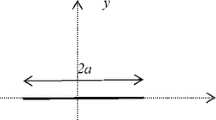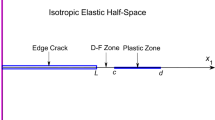Summary
The method of dislocation layers is used to study the stress-field created around an infinite row of collinear Griffith-type elastoplastic strip cracks in an orthotropic crystal loaded at infinity. Formal solutions are obtained in detail for the mode III antiplane shear case, leading to explicit expressions for the length of the plastic zones and the total plastic displacement at the crack-tips. Some representative numerical results are given. It is observed that the problems of a single, elastoplastic crack within a finite orthotropic plate and a finite plate containing a surface crack have solutions which are actually also provided by this analysis. The mode I and mode II analogous situations are briefly discussed.
Similar content being viewed by others
References
Bilby, B. A., Eshelby, J. D.: Fracture (Liebowitz, H., ed.), Vol. 1, p. 99. New York: Academic Press, 1968.
Lardner, R. W.: Mathematical theory of dislocations and fracture. University of Toronto Press, 1974.
Sneddon, I. N., Lowengrub, M.: Crack problems in the classical theory of elasticity. New York: Wiley 1969.
Sih, G. C., ed.: Methods of analysis and solutions of crack problems. Mechanics of fracture, Vol. 1. Leyden: Noordhoff Int. Pub. 1973.
Bilby, B. A., Cottrell, A. H., Swinden, K.: The spread of plastic yield from a notch. Proc. Roy. Soc.A 272, 304–314 (1963).
Singh, B. M., Moodie, T. B., Haddow, J. B.: Closed-form solutions for finite length crack moving in a strip under anti-plane shear stress. Acta Mech.38, 99–109 (1981).
Tait, R. J., Moodie, T. B.: Complex variable methods and closed form solutions to dynamic crack and punch problems in the classical theory of elasticity. Int. J. Engng. Sci.19, 221–229 (1981).
Georgiadis, H. G., Theocaris, P. S.: The Keldysh-Sedov method for a closed-form elastodynamic solution of the cracked strip under anti-plane shear. Int. J. Engng. Sci.24, 1135–1140 (1986).
Bilby, B. A., Cottrell, A. H., Smith, E., Swinden, K. H.: Plastic yielding from sharp notches. Proc. Roy. Soc.A 279, 1–9 (1964).
Chou, Y. T., Sha, G. T.: On the elastic field of a dislocation in an anistoropic crystal. Scrip. Metal.5, 551–558 (1971).
Chou, Y. T.: Interaction of parallel dislocations in a hexagonal crystal. J. Appl. Phys.33, 2747–2751 (1962).
Chou, Y. T., Garofalo, F., Whitmore, R. W.: Interactions between glide dislocations in a double pile-up in α-iron. Acta Met.9, 480–488 (1960).
Chou, Y. T., Whitmore, R. W.: Single and double pile-up of dislocations in MgO crystals. J. Appl. Phys.32, 1920–1926 (1961).
Tupholme, G. E.: A study of cracks in orthotropic crystals using dislocation layers. J. Eng. Math.8, 57–69 (1974).
Leibfried, G.: Verteilung von Versetzungen im statischen Gleichgewicht. Z. Phys.130, 214–226 (1951).
Muskhelishvili, N. I.: Singular integral equations. Leyden: Noordhoff Int. Pub., 1953.
Gakhov, F. D.: Boundary value problems. Oxford: Pergamon 1966.
Hearmon, R. F. S.: The elastic constants of crystals and other anisotropic materials; Landolt-Börnstein.Numerical data and functional relationships in science and technology (New series, Editor in Chief: Hellwege, K.-H.). Group III: Crystal and solid state physics, Vol. 11: Elastic, piezoelectric, pyroelectric, piezooptic, electrooptic constants, and nonlinear dielectric susceptibilities of crystals, pp. 1–78, (1979). Berlin-Heidelberg-New York: Springer 1979.
Author information
Authors and Affiliations
Rights and permissions
About this article
Cite this article
Tupholme, G.E. Elastoplastic cracks in orthotropic crystals using dislocation layers. Acta Mechanica 73, 177–185 (1988). https://doi.org/10.1007/BF01177037
Received:
Issue Date:
DOI: https://doi.org/10.1007/BF01177037




